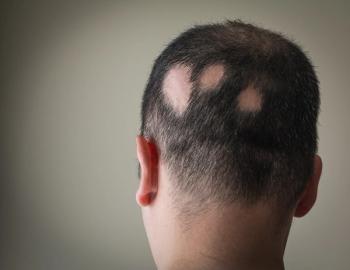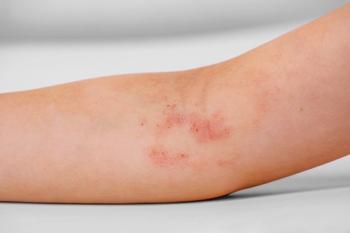
- Consultant for Pediatricians Vol 4 No 6
- Volume 4
- Issue 6
Aplasia Cutis Congenita in an Infant
Developmentally healthy 9-month-old boy brought for evaluation of congenital pale pink 2-cm plaque on left parietal scalp. Lesion relatively unchanged since birth. No history of birth trauma or scalp electrode monitoring in the intrapartum period. Mother denied varicella infection during pregnancy.
HISTORY
Developmentally healthy 9-month-old boy brought for evaluation of congenital pale pink 2-cm plaque on left parietal scalp. Lesion relatively unchanged since birth. No history of birth trauma or scalp electrode monitoring in the intrapartum period. Mother denied varicella infection during pregnancy.
PHYSICAL EXAMINATION
Lesion surrounded by a whorl of luxuriant dark hair more coarse and longer than surrounding scalp hair.
Remainder of examination within normal limits. No other dysmorphic features noted.
"WHAT'S YOUR DIAGNOSIS?"
ANSWER: "HAIR COLLAR" SIGN
The "hair collar" sign has been associated with multiple neurocutaneous defects and should alert the practitioner to the possibility of underlying CNS malformations or ectopic neural tissue within the scalp.1 Encephaloceles, meningoceles, and heterotopic brain tissue have all been associated with this finding.1,2 Midline lesions are of particular concern and should be investigated as soon as they are recognized.
All infants with a "hair collar" lesion need an evaluation that includes a complete physical and neurologic examination, as well as CT or MRI scans of the head. Skin biopsy or needle aspiration is not recommended until imaging is complete because of the risk of hemorrhage and/or retrograde infection if the lesion communicates with the brain or a major blood vessel. Prompt neurosurgical referral is advised if intracranial communications are discovered.
In our patient, an MRI scan of the head showed that the lesion was localized to the scalp with no underlying communications. Aplasia cutis congenita (ACC) was diagnosed. In this condition, which is also associated with "hair collar" sign, localized or widespread areas of the epidermis, dermis, and rarely, subcutis are absent or scarredat birth. ACC is often a benign isolated defect, and treatment is usually not necessary since healing by secondary intent is often satisfactory.3 ACC can be associated with other developmental anomalies or syndromes, however. Genetic counseling is thus advised for affected patients.
References:
REFERENCES:
1. Drolet BA, Clowry L Jr, McTigue MK, Esterly NB. The hair collar sign: marker for cranial dysraphism.
Pediatrics.
1995;96(2 pt 1):309-313.
2. Commens C, Rogers M, Kan A. Heterotropic brain tissue presenting as bald cysts with a collar of hypertrophic hair. The "hair collar" sign.
Arch Dermatol.
1989;125:1253-1256.
3. Guillen PS, Pichardo AR, Martinez FC. Aplasia cutis congenital.
J Am Dermatol.
1985;13:429-433.
Articles in this issue
over 20 years ago
Vaccine-Induced Herpes Zosterover 20 years ago
Case in Point: Insights on a "Global" Issueover 20 years ago
Case In Point: Erythema Ab Igneover 20 years ago
Meningococcal Immunization Update: A New Conjugate Vaccineover 20 years ago
Photoclinic: Asymmetric Crying Facies Syndromeover 20 years ago
Gianotti-Crosti Syndrome and Hemangiomasover 20 years ago
Consultations & Comments: Why the Spotlight on Obesity?Newsletter
Access practical, evidence-based guidance to support better care for our youngest patients. Join our email list for the latest clinical updates.














